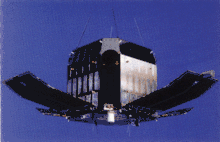Tenma
Tenma, known as ASTRO-B before launch (COSPAR 1983-011A, SATCAT 13829), was a Japanese X-ray astronomy satellite, developed by the Institute of Space and Astronautical Science. It was launched on February 20, 1983, using a M-3S rocket on the M-3S-3 mission.
For other uses, see Tenma (disambiguation).

Tenma (Japanese for "Pegasus").
Battery failure in July 1984 caused the operation to become limited, and continuing problems lead to the termination of X-ray observation in 1985. It reentered the atmosphere on January 19, 1989 (other sources, for example the NORAD catalog of satellites, say decay date (the day it stopped working) was 17 May 1988[1]).
Highlights
- Discovery of the iron helium-like emission from the galactic ridge
- Iron line discovery and/or study in many LMXRB, HMXRB and AGN
- Discovery of an absorption line at 4 keV in the X1636-536 Burst spectra
See also
References
External links
| Operating |
|
|---|---|
| Planned |
|
| Proposed | |
| Retired |
|
| Hibernating (Mission completed) | |
| Lost/Failed | |
| Cancelled | |
| Related | |
| |
| Astronomical observation |
| ||||||||||||
|---|---|---|---|---|---|---|---|---|---|---|---|---|---|
| Communications, broadcasting and navigation |
| ||||||||||||
| Earth observation |
| ||||||||||||
| Engineering tests |
| ||||||||||||
| Human spaceflight |
| ||||||||||||
| Lunar and planetary exploration |
| ||||||||||||
| Private miniaturized satellites |
| ||||||||||||
| Reconnaissance |
| ||||||||||||
Kosmos 1428 | Kosmos 1429 · Kosmos 1430 · Kosmos 1431 · Kosmos 1432 · Kosmos 1433 · Kosmos 1434 · Kosmos 1435 · Kosmos 1436 | Kosmos 1437 | Unnamed | IRAS · PIX-2 | Kosmos 1438 | Sakura 2a | Kosmos 1439 | OPS 0252 · OPS 0252 SSU-1 · OPS 0252 SSU-2 · OPS 0252 SSU-3 · LIPS-2 | Kosmos 1440 | Kosmos 1441 | Tenma | Kosmos 1442 | Kosmos 1443 | Kosmos 1444 | Molniya-3 No.34 | Ekran No.18L | Kosmos 1445 | Kosmos 1446 | Molniya-1-56 | Astron | Kosmos 1447 | NOAA-8 | Kosmos 1448 | Kosmos 1449 | Molniya-1 No.68 | STS-6 (TDRS-1) | Kosmos 1450 | Gran' No.23L | Kosmos 1451 | Satcom 1R | Kosmos 1452 | OPS 2925 | Rohini RS-D2 | Kosmos 1453 | Soyuz T-8 | Kosmos 1454 | Kosmos 1455 | Kosmos 1456 | Kosmos 1457 | Kosmos 1458 | GOES 6 | Kosmos 1459 | Kosmos 1460 | Kosmos 1461 | Kosmos 1462 | Kosmos 1463 | Intelsat V F-6 | Kosmos 1464 | Kosmos 1465 | Kosmos 1466 | EXOSAT | Kosmos 1467 | Venera 15 | Venera 16 | Kosmos 1468 | OPS 6432 · OPS 6432 SSU-1 · OPS 6432 SSU-2 · OPS 6432 SSU-3 | Kosmos 1469 | ECS-1 · OSCAR-10 | STS-7 (Anik C2 · Palapa B1 · SPAS-01 · OSTA-2) | OPS 0721 · OPS 3899 | Kosmos 1470 | Soyuz T-9 | HILAT | Kosmos 1471 | Galaxy 1 | Gorizont No.17L | Prognoz 9 | Kosmos 1472 | Kosmos 1473 · Kosmos 1474 · Kosmos 1475 · Kosmos 1476 · Kosmos 1477 · Kosmos 1478 · Kosmos 1479 · Kosmos 1480 | Kosmos 1481 | Kosmos 1482 | OPS 7994 | Molniya-1 No.66 | Kosmos 1483 | Kosmos 1484 | Kosmos 1485 | Telstar 301 | OPS 7304 | Kosmos 1486 | Kosmos 1487 | Sakura 2b | Kosmos 1488 | Kosmos 1489 | Kosmos 1490 · Kosmos 1491 · Kosmos 1492 | Progress 17 | Fanhui Shi Weixing 6 | Kosmos 1493 | Gran' No.24L | STS-8 (INSAT-1B) | Molniya-3 No.32 | Kosmos 1494 | Kosmos 1495 | Kosmos 1496 | Satcom 2R | Kosmos 1497 | Kosmos 1498 | Kosmos 1499 | Galaxy-2 | Soyuz 7K-ST No. 16L | Kosmos 1500 | Ekran No.25L | Kosmos 1501 | Kosmos 1502 | Kosmos 1503 | Kosmos 1504 | Intelsat V F-7 | Progress 18 | Kosmos 1505 | Kosmos 1506 | Meteor-2 No.10 | Kosmos 1507 | Kosmos 1508 | Kosmos 1509 | OPS 1294 | Molniya-1 No.48 | Kosmos 1510 | STS-9 | Kosmos 1511 | Gorizont No.18L | Kosmos 1512 | Kosmos 1513 | Kosmos 1514 | Kosmos 1515 | Molniya-3 No.35 | Kosmos 1516 | Kosmos 1517 | Kosmos 1518 | Kosmos 1519 · Kosmos 1520 · Kosmos 1521 | |
Payloads are separated by bullets ( · ), launches by pipes ( | ). Crewed flights are indicated in underline. Uncatalogued launch failures are listed in italics. Payloads deployed from other spacecraft are denoted in (brackets). |
This article is issued from Wikipedia. The text is licensed under Creative Commons - Attribution - Sharealike. Additional terms may apply for the media files.